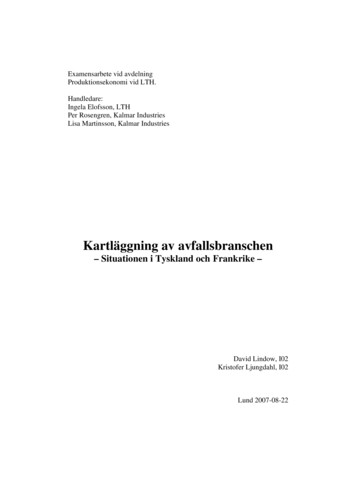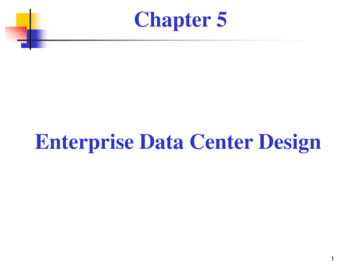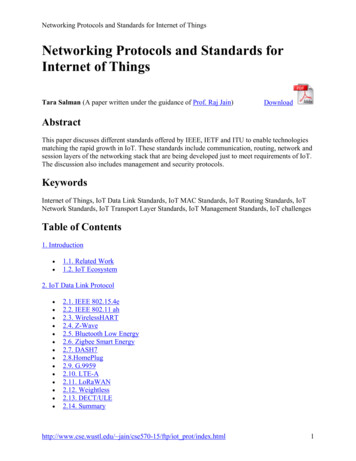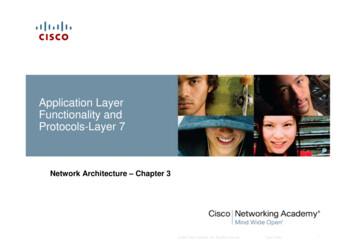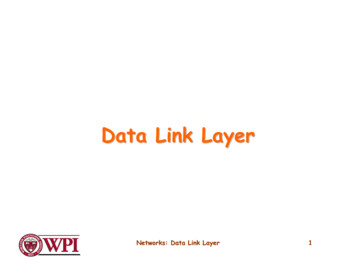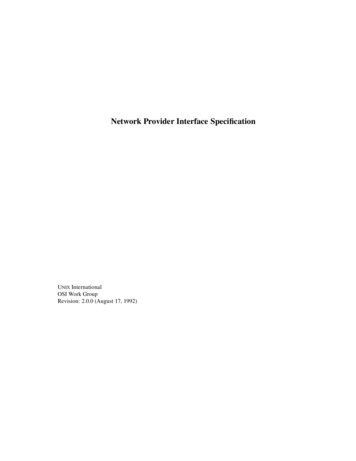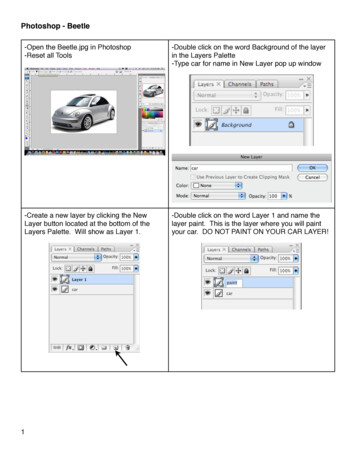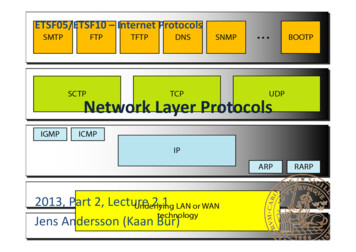
Transcription
ETSF05/ETSF10 – Internet ProtocolsNetwork Layer Protocols2013, Part 2, Lecture 2.1Jens Andersson (Kaan Bür)
Route Transfer2013‐11‐11ETSF05/ETSF10 ‐ Internet Protocols2
Scope of IGMP2013‐11‐11ETSF05/ETSF10 ‐ Internet Protocols3
IGMP: Designated/Parent Router2013‐11‐11ETSF05/ETSF10 ‐ Internet Protocols4
Network layer L3 is end‐to‐end L2 is host‐to‐host2013‐11‐11ETSF05/ETSF10 ‐ Internet Protocols6
Network layer: Routing L3 is end‐to‐endTwo functions:❶ Finding best path❷ Forwarding2013‐11‐11ETSF05/ETSF10 ‐ Internet Protocols7
Forwarding: Address aggregation2013‐10‐29ETSF05/ETSF10 ‐ Internet Protocols8
Forwarding: Longest mask matching2013‐10‐29ETSF05/ETSF10 ‐ Internet Protocols9
Forwarding: Hierarchical routingISP2013‐10‐29ETSF05/ETSF10 ‐ Internet Protocols10
Forwarding based on destinationaddress2013‐11‐11ETSF05/ETSF10 ‐ Internet Protocols11
Label Switching Switching is more efficient than routing Create one path instead of routing/forwardingeach individual packet hop by hop– Switching still hop by hop– Compare ATM switching MPLS (Multi‐Protocol Lable Switching)2013‐11‐11ETSF05/ETSF10 ‐ Internet Protocols12
Forwarding based on label2013‐11‐11ETSF05/ETSF10 ‐ Internet Protocols13
MPLS header made of a stack of labels Ex: One label for outside an organisation Ex: One label for inside a organisation Compare hierarchical routing2013‐11‐11ETSF05/ETSF10 ‐ Internet Protocols14
Internet ProtocolIPv4IPv6 Addressing scheme Larger address space Better header format– Hierarchy– Configuration– Lookup Datagram format2013‐11‐11– Extendible– More secure Support for QoSETSF05/ETSF10 ‐ Internet Protocols15
IPv4 addresses 32 bits 4 bytes4328 2 (2 ) 2564 4 294 967 296 Classful vs. classless hierarchy Notations– Dotted decimal– Slash (CIDR)2013‐11‐11ETSF05/ETSF10 ‐ Internet Protocols16
Classless addressing Addresses in blocks– Block size power of 2– N 232‐n2013‐11‐11ETSF05/ETSF10 ‐ Internet Protocols17
Example: Classless addressing 205.16.37.39/282013‐11‐11ETSF05/ETSF10 ‐ Internet Protocols18
IPv6 addresses 128 bits 16 bytes 2128 232 296 3 1035 Notations2013‐11‐11ETSF05/ETSF10 ‐ Internet Protocols19
Prefixes for assigned IPv6 addresses2013‐11‐11ETSF05/ETSF10 ‐ Internet Protocols20
Global unicast addresses Identify individual 05/ETSF10 ‐ Internet Protocols21
AUTOCONFIGA few special IPv6 addresses2013‐11‐11ETSF05/ETSF10 ‐ Internet Protocols22
IPv4 datagram2013‐11‐11ETSF05/ETSF10 ‐ Internet Protocols23
Service type field2013‐11‐11ETSF05/ETSF10 ‐ Internet Protocols24
IPv6 datagram Simpler base header, flexible for extensions2013‐11‐11ETSF05/ETSF10 ‐ Internet Protocols25
IPv6 extension headers2013‐11‐11ETSF05/ETSF10 ‐ Internet Protocols26
Traffic Classes Æ Packet priorities 0 . 7– Congestioncontrolled 8 . 15– F10 ‐ Internet Protocols27
IPv6 and QoSFlow labelTraffic classCROSS‐ Identification of a streamLAYER? Classification of packets Processing TCP vs. UDP– TCP sessions– Virtual connections– Flow label table– Forwarding table– Congestion‐controlled– Non‐congestion‐controlled Routing Other protocols– Algorithms still necessary– But not run for every packet!2013‐11‐11– Queueing schemes– Relation to delay– RTP– RSVPETSF05/ETSF10 ‐ Internet Protocols28
Transition: IPv4 Æ IPv6 Cannot happen overnight– Too many independent systems– Economic cost– IPv4 address space lasted longer than expected CoexistSence needed2013‐11‐11ETSF05/ETSF10 ‐ Internet Protocols29
Transition: (1) Dual stack Decision based on destination IP2013‐11‐11ETSF05/ETSF10 ‐ Internet Protocols30
Transition: (2) Tunneling A few IPv6 routers2013‐11‐11ETSF05/ETSF10 ‐ Internet Protocols31
Transition: (3) Header translation A few IPv4 routers2013‐11‐11ETSF05/ETSF10 ‐ Internet Protocols32
Internet Control Message Protocol ICMP Support protocol for IP– Error reporting– Query2013‐11‐11ETSF05/ETSF10 ‐ Internet Protocols33
ICMPv4 message types2013‐11‐11ETSF05/ETSF10 ‐ Internet Protocols34
ICMP message formats Error reporting Query messages2013‐11‐11ETSF05/ETSF10 ‐ Internet Protocols35
(errorreportingtype)Redirection Routing update for hosts– SF05/ETSF10 ‐ Internet Protocols36
Echo request and(querytype)reply Is my destination alive? Network diagnostics– IP layer Debugging tools– Ping– Traceroute2013‐11‐11ETSF05/ETSF10 ‐ Internet Protocols37
TracerouteEcho request2013‐11‐11ETSF05/ETSF10 ‐ Internet Protocols38
Changes to ICMPICMPv4ICMPv6 Some unused functions 2013‐11‐11Same principleSome new functionsConvergenceSuits IPv6 betterETSF05/ETSF10 ‐ Internet Protocols40
Virtual Private Network (VPN) Overlay network Alternative to a real private network2013‐11‐11ETSF05/ETSF10 ‐ Internet Protocols46
An example VPN IPSec between routers2013‐11‐11ETSF05/ETSF10 ‐ Internet Protocols47
IPSecTransport modeTunnel modeTH2013‐11‐11ETSF05/ETSF10 ‐ Internet Protocols48
Transport mode in action Data protected Headers unprotected– Addresses fully visible2013‐11‐11ETSF05/ETSF10 ‐ Internet Protocols49
Tunnel mode in action Not used between hosts Entire packet protected– New header inside tunnel2013‐11‐11ETSF05/ETSF10 ‐ Internet Protocols50
Internet security (discussed in othercourses)2013‐11‐11ETSF05/ETSF10 ‐ Internet Protocols51
VPN alternatives (bonus material) PPTP (Point‐to‐Point Tunneling Protocol)L2TP (Layer 2 Tunneling Protocol)SSTP (Secure Socket Tunneling Protocol)OpenVPN See Wikipedia for information2013‐11‐11ETSF05/ETSF10 ‐ Internet Protocols52
Classful vs. classless hierarchy Notations - Dotted decimal - Slash (CIDR) . - N 232‐n 2013‐11‐11 ETSF05/ETSF10 ‐Internet Protocols 17. Example: Classless addressing 205.16.37.39/28 2013‐11‐11 ETSF05/ETSF10 ‐Internet Protocols 18. IPv6 addresses 128 bits 16 bytes 2128 232 296 3 1035
